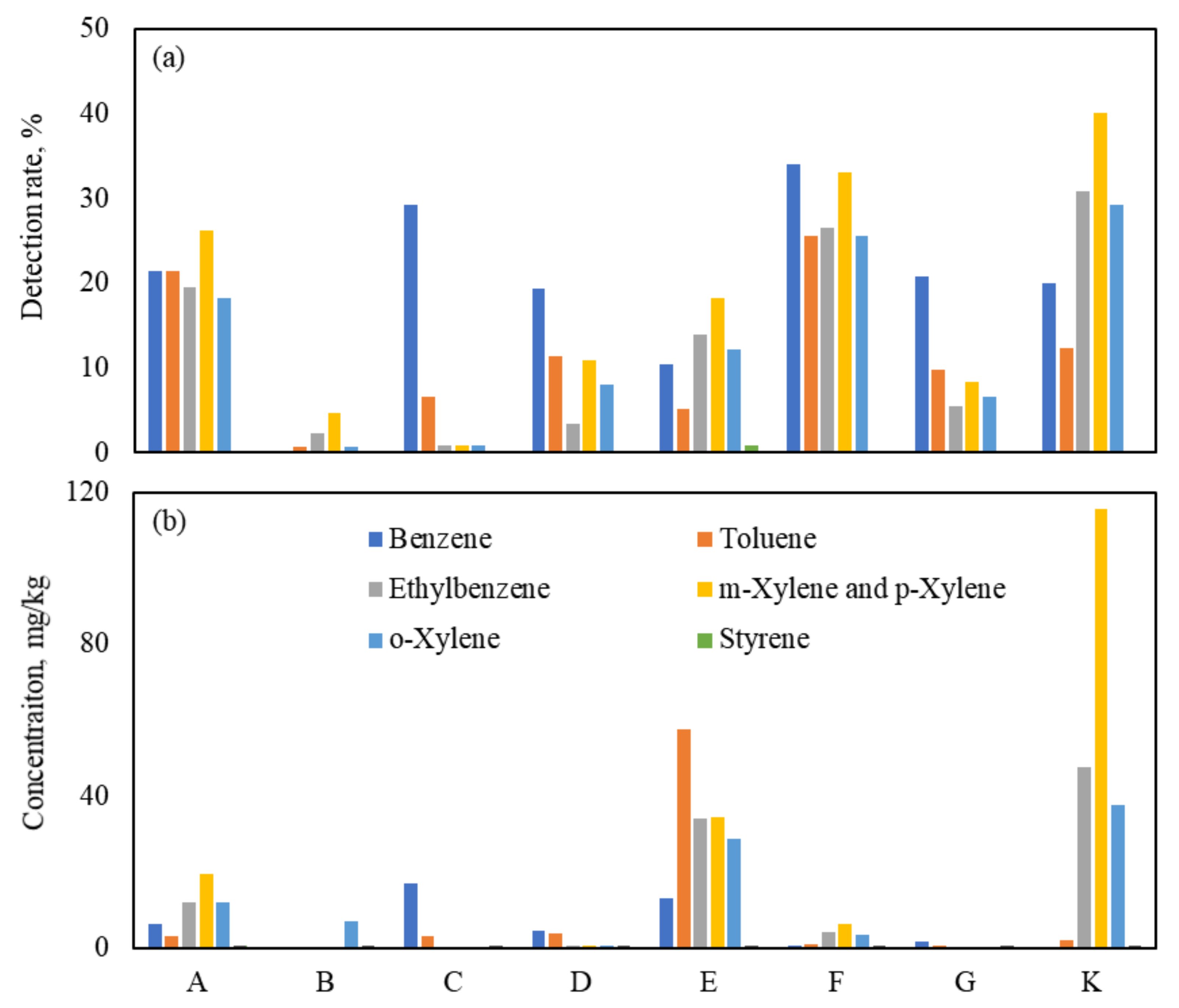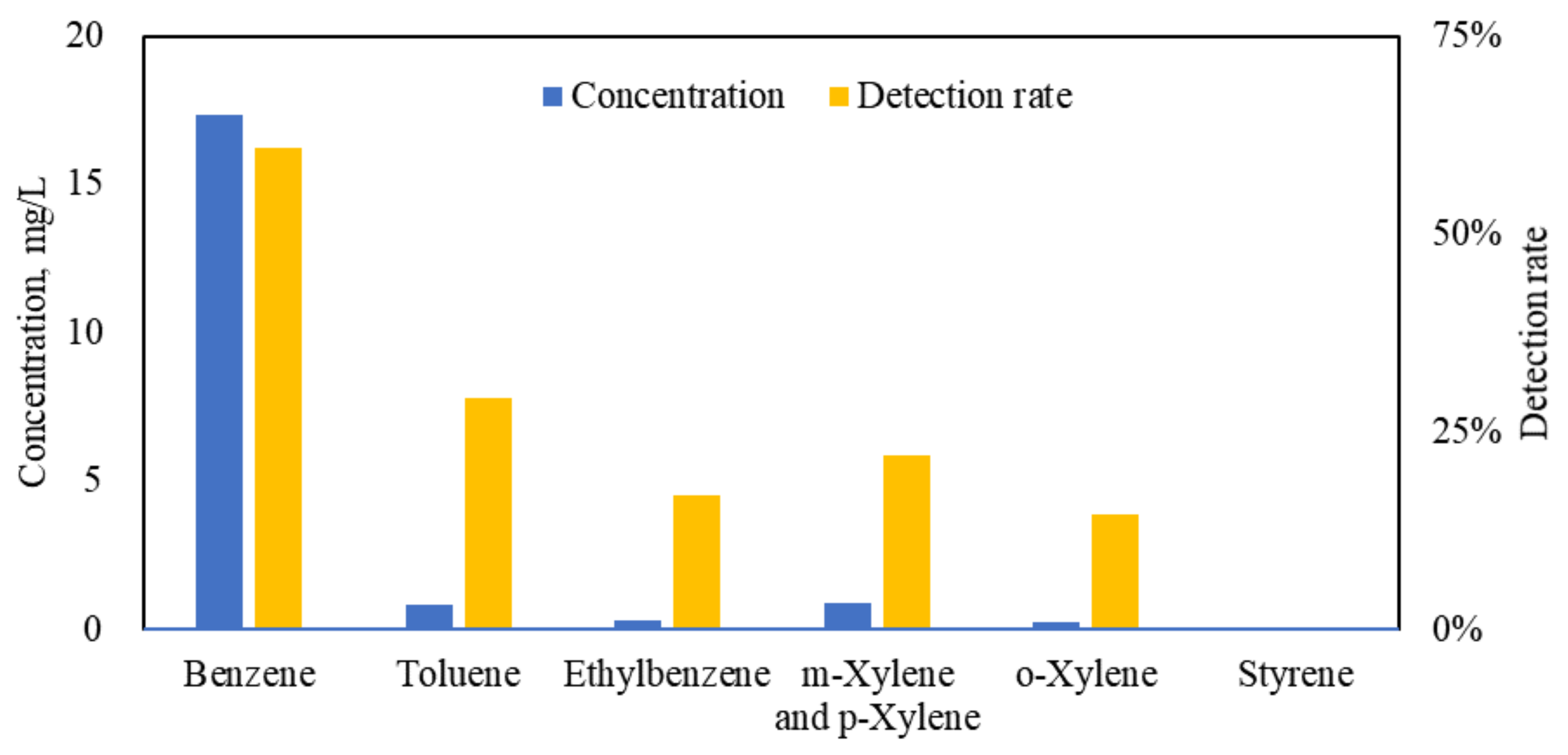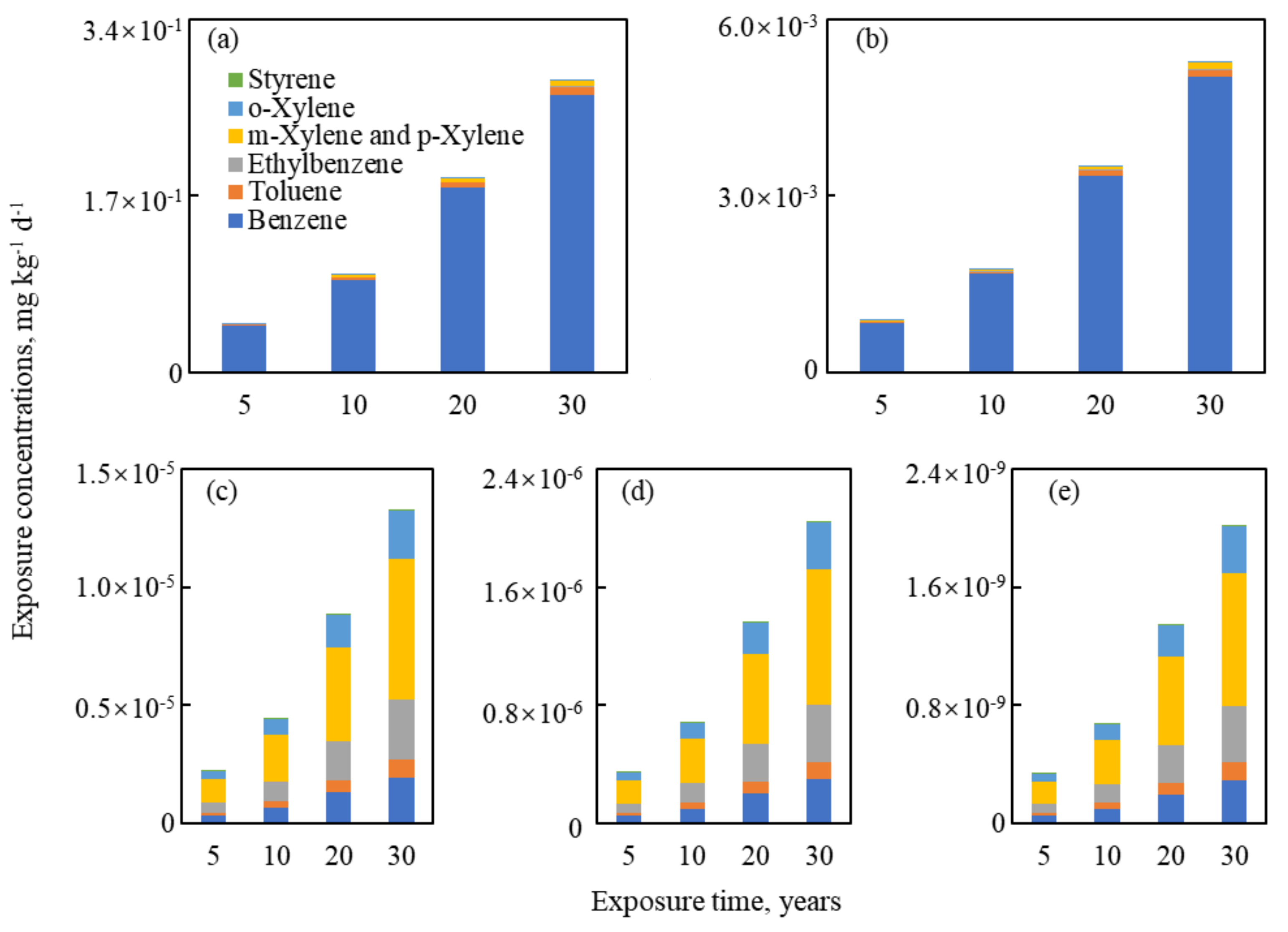Evaluation of BTEX Pollution and Health Risk for Sustainable Use of a Typical Chemical Pesticide Industrial Site
Abstract
:1. Introduction
2. Materials and Methods
2.1. Study Area
2.2. Sample Collection and Analysis
2.2.1. Sample Collection
2.2.2. Laboratory Testing and Quality Assurance
2.3. Health Risk Assessment
3. Results
3.1. BTEX in Soil
3.2. BTEX in Groundwater
3.3. Cancer Risks
3.4. Non-Cancer Risk
4. Discussion
4.1. Factors Influencing BTEX Pollution Levels
4.2. Implications for Remediation Strategies and Sustainable Use of the Industry Site
5. Conclusions
Author Contributions
Funding
Institutional Review Board Statement
Informed Consent Statement
Data Availability Statement
Conflicts of Interest
References
- Yu, B.; Yuan, Z.; Yu, Z.; Xue-song, F. BTEX in the Environment: An Update on Sources, Fate, Distribution, Pretreatment, Analysis, and Removal Techniques. Chem. Eng. J. 2022, 435, 134825. [Google Scholar] [CrossRef]
- Dantas, G.; Gorne, I.; da Silva, C.M.; Arbilla, G. Benzene, Toluene, Ethylbenzene and Xylene (BTEX) Concentrations in Urban Areas Impacted by Chemical and Petrochemical Industrial Emissions. Bull. Environ. Contam. Toxicol. 2022, 108, 204–211. [Google Scholar] [CrossRef] [PubMed]
- Guo, H.; Wang, T.; Simpson, I.J.; Blake, D.R.; Yu, X.M.; Kwok, Y.H.; Li, Y.S. Source Contributions to Ambient VOCs and CO at a Rural Site in Eastern China. Atmos. Environ. 2004, 38, 4551–4560. [Google Scholar] [CrossRef]
- Li, A.J.; Pal, V.K.; Kannan, K. A Review of Environmental Occurrence, Toxicity, Biotransformation and Biomonitoring of Volatile Organic Compounds. Environ. Chem. Ecotoxicol. 2021, 3, 91–116. [Google Scholar] [CrossRef]
- Zahed, M.A.; Salehi, S.; Khoei, M.A.; Esmaeili, P.; Mohajeri, L. Risk Assessment of Benzene, Toluene, Ethyl Benzene, and Xylene (BTEX) in the Atmospheric Air around the World: A Review. Toxicol. Vitr. 2024, 98, 105825. [Google Scholar] [CrossRef] [PubMed]
- Chiavarini, M.; Rosignoli, P.; Sorbara, B.; Giacchetta, I.; Fabiani, R. Benzene Exposure and Lung Cancer Risk: A Systematic Review and Meta-Analysis of Human Studies. Int. J. Environ. Res. Public Health 2024, 21, 205. [Google Scholar] [CrossRef] [PubMed]
- Galbraith, D.; Gross, S.A.; Paustenbach, D. Benzene and Human Health: A Historical Review and Appraisal of Associations with Various Diseases. Crit. Rev. Toxicol. 2010, 40, 1–26. [Google Scholar] [CrossRef] [PubMed]
- Werder, E.J.; Engel, L.S.; Blair, A.; Kwok, R.K.; McGrath, J.A.; Sandler, D.P. Blood BTEX Levels and Neurologic Symptoms in Gulf States Residents. Environ. Res. 2019, 175, 100–107. [Google Scholar] [CrossRef]
- Niaz, K.; Bahadar, H.; Maqbool, F.; Abdollahi, M. A Review of Environmental and Occupational Exposure to Xylene and Its Health Concerns. EXCLI J. 2015, 14, 1167–1186. [Google Scholar] [CrossRef]
- Kirkeleit, J.; Riise, T.; Gjertsen, B.T.; Moen, B.E.; Bråtveit, M.; Bruserud, Ø. Effects of Benzene on Human Hematopoiesis. Open Hematol. J. 2008, 2, 87–102. [Google Scholar] [CrossRef]
- Aksoy, M. Hematotoxicity and Carcinogenicity of Benzene. Environ. Health Perspect. 1989, 82, 193–197. [Google Scholar] [CrossRef] [PubMed]
- Zhvania, M.G.; Pochkhidze, N.; Dashniani, M.; Tizabi, Y.; Japaridze, N.; Burjanadze, M.; Chilachava, L. Short- and Long-Term Effects of Chronic Toluene Exposure on Recognition Memory in Adolescent and Adult Male Wistar Rats. Brain Res. Bull. 2022, 190, 116–121. [Google Scholar] [CrossRef] [PubMed]
- Win-Shwe, T.-T.; Fujimaki, H. Neurotoxicity of Toluene. Toxicol. Lett. 2010, 198, 93–99. [Google Scholar] [CrossRef] [PubMed]
- Abduljalel, M.E.; Al-Saadi, R.N. Toxicopathological Effect Of Benzene, Toluene, Ethylbenzene, And Xylenes (BTEX) As A Mixture And The Protective Effect Of Citicoline In Male Rats Followings 90-Day Oral Exposure. Rev. Electron. Vet. 2022, 23, 399–414. [Google Scholar]
- Gamberale, F.; Annwall, G.; Hultengren, M. Exposure to Xylene and Ethylbenzene: III. Effects on Central Nervous Functions. Scand. J. Work. Environ. Health 1978, 4, 204–211. [Google Scholar] [CrossRef] [PubMed]
- Toftgård, R.; Nilsen, O.G. Effects of Xylene and Xylene Isomers on Cytochrome P-450 and in Vitro Enzymatic Activities in Rat Liver, Kidney and Lung. Toxicology 1982, 23, 197–212. [Google Scholar] [CrossRef] [PubMed]
- International Agency for Research on Cancer. IARC Monographs on the Evaluation of Carcinogenic Risks to Humans. 2018. Available online: https://publications.iarc.fr/Book-And-Report-Series/Iarc-Monographs-On-The-Identification-Of-Carcinogenic-Hazards-To-Humans/Benzene-2018 (accessed on 2 July 2024).
- Loomis, D.; Guyton, K.Z.; Grosse, Y.; Ghissassi, F.E.; Bouvard, V.; Benbrahim-Tallaa, L.; Guha, N.; Vilahur, N.; Mattock, H.; Straif, K. Carcinogenicity of Benzene. Lancet Oncol. 2017, 18, 1574–1575. [Google Scholar] [CrossRef] [PubMed]
- Bai, C.; Xie, D.; Zhang, Y. Industrial Land Transfer and Enterprise Pollution Emissions: Evidence from China. Econ. Anal. Policy 2024, 81, 181–194. [Google Scholar] [CrossRef]
- Wcisło, E.; Bronder, J.; Bubak, A.; Rodríguez-Valdés, E.; Gallego, J.L.R. Human Health Risk Assessment in Restoring Safe and Productive Use of Abandoned Contaminated Sites. Environ. Int. 2016, 94, 436–448. [Google Scholar] [CrossRef]
- Swartjes, F.A.; Rutgers, M.; Lijzen, J.P.A.; Janssen, P.J.C.M.; Otte, P.F.; Wintersen, A.; Brand, E.; Posthuma, L. State of the Art of Contaminated Site Management in The Netherlands: Policy Framework and Risk Assessment Tools. Sci. Total Environ. 2012, 427–428, 1–10. [Google Scholar] [CrossRef]
- Higueras, P.L.; Sáez-Martínez, F.J.; Lefebvre, G.; Moilleron, R. Contaminated Sites, Waste Management, and Green Chemistry: New Challenges from Monitoring to Remediation. Environ. Sci. Pollut. Res. 2019, 26, 3095–3099. [Google Scholar] [CrossRef]
- United States Environmental Protection Agency. IRIS Assessment: Benzene (CASRN 71-43-2|DTXSID3039242). Available online: https://iris.epa.gov/ChemicalLanding/&substance_nmbr=276 (accessed on 2 July 2024).
- Spira, Y.; Henstock, J.; Nathanail, P.; Müller, D.; Edwards, D. A European Approach to Increase Innovative Soil and Groundwater Remediation Technology Applications. Remediat. J. 2006, 16, 81–96. [Google Scholar] [CrossRef]
- Arias Espana, V.A.; Rodriguez Pinilla, A.R.; Bardos, P.; Naidu, R. Contaminated Land in Colombia: A Critical Review of Current Status and Future Approach for the Management of Contaminated Sites. Sci. Total Environ. 2018, 618, 199–209. [Google Scholar] [CrossRef]
- Kuppusamy, S.; Palanisami, T.; Megharaj, M.; Venkateswarlu, K.; Naidu, R. In-Situ Remediation Approaches for the Management of Contaminated Sites: A Comprehensive Overview. In Reviews of Environmental Contamination and Toxicology Volume 236; de Voogt, P., Ed.; Springer International Publishing: Cham, Switzerland, 2016; pp. 1–115. ISBN 978-3-319-20013-2. [Google Scholar]
- State Council of the People’s Republic of China. Notice on Printing and Distributing the Implementation Plan for the Prevention and Control of Groundwater Pollution. 2019. Available online: https://www.gov.cn/zhengce/zhengceku/2019-10/10/content_5438142.htm (accessed on 2 July 2024).
- State Council of the People’s Republic of China. Soil Pollution Prevention and Control Action Plan. 2016. Available online: https://www.gov.cn/zhengce/content/2016-05/31/content_5078377.htm (accessed on 2 July 2024).
- United States Environmental Protection Agency. Method_8260c: Volatile Organic Compounds by Gas Chromatography/Mass Spectrometry. 2006. Available online: https://www.epa.gov/sites/default/files/2018-06/documents/method_8260c_rev_3_8-1-2006.pdf (accessed on 5 July 2024).
- United States Environmental Protection Agency. Guidelines for Exposure Assessment. 1992. Available online: https://cfpub.epa.gov/ncea/risk/recordisplay.cfm?deid=15263 (accessed on 5 July 2024).
- GB36600-2018; Soil Environmental Quality: Risk Control Standard for Soil Contamination of Development Land. Ministry of Ecology and Environment of the People’s Republic of China: Beijing, China, 2018. Available online: https://www.mee.gov.cn/ywgz/fgbz/bz/bzwb/trhj/201807/t20180703_446027.shtml (accessed on 6 July 2024).
- GB/T 14848-2017; Standard for Groundwater Quality. Standardization Administration of China: Beijing, China, 2017. Available online: https://huanbao.bjx.com.cn/news/20171102/858959.shtml (accessed on 6 July 2024).
- Wang, Z.; Liu, S.; Chen, X.; Lin, C. Estimation of Skin Exposure Area for the Chinese Population in Health Risk Assessment. J. Saf. Environ. 2008, 8, 152–156. [Google Scholar]
- Zang, Z.; Zhao, Y.; Wei, L.; Ye, Y.; Song, Y. Human Health Risk Assessment of an Abandoned Chemical Plant in Beijing. Asian J. Ecotox. 2008, 3, 48–54. [Google Scholar]
- United States Environmental Protection Agency. Exposure Factors Handbook. 2011. Available online: https://www.epa.gov/expobox/about-exposure-factors-handbook (accessed on 6 July 2024).
- Pang, B.; Wang, T.; Du, L.; Tan, B.; Zhu, Z.; Lv, Y. Risk Assessment and Countermeasure of BTEX in Pesticide Factory. Environ. Sci. 2013, 34, 2829–2836. [Google Scholar] [CrossRef]
- Huang, Y.; Guenet, B.; Wang, Y.L.; Ciais, P. Global Simulation and Evaluation of Soil Organic Matter and Microbial Carbon and Nitrogen Stocks Using the Microbial Decomposition Model ORCHIMIC v2.0. Glob. Biogeochem. Cycles 2021, 35, e2020GB006836. [Google Scholar] [CrossRef]
- Li, C.; Voudrias, E.A. Effect of Organic Carbon on the Uptake of Benzene Vapor by Soil. Environ. Technol. 1993, 14, 189–194. [Google Scholar] [CrossRef]
- Steinberg, S.M.; Schmeltzer, J.S.; Kreamer, D.K. Sorption of Benzene and Trichloroethylene (TCE) on a Desert Soil: Effects of Moisture and Organic Matter. Chemosphere 1996, 33, 961–980. [Google Scholar] [CrossRef]
- Vaezihir, A.; Zare, M.; Raeisi, E.; Molson, J.; Barker, J. Field-Scale Modeling of Benzene, Toluene, Ethylbenzene, and Xylenes (BTEX) Released from Multiple Source Zones. Bioremediation J. 2012, 16, 156–176. [Google Scholar] [CrossRef]
- Xue, W.; Ying, D.; Li, Y.; Sheng, Y.; He, T.; Shi, P.; Liu, M.; Zhao, L. Method for Establishing Soil Contaminant Discharge Inventory: An Arsenic-Contaminated Site Case Study. Environ. Res. 2023, 227, 115700. [Google Scholar] [CrossRef] [PubMed]
- Mohd Hanif, N.; Limi Hawari, N.S.S.; Othman, M.; Abd Hamid, H.H.; Ahamad, F.; Uning, R.; Ooi, M.C.G.; Wahab, M.I.A.; Sahani, M.; Latif, M.T. Ambient Volatile Organic Compounds in Tropical Environments: Potential Sources, Composition and Impacts—A Review. Chemosphere 2021, 285, 131355. [Google Scholar] [CrossRef] [PubMed]
- Cousins, I.T.; Beck, A.J.; Jones, K.C. A Review of the Processes Involved in the Exchange of Semi-Volatile Organic Compounds (SVOC) across the Air–Soil Interface. Sci. Total Environ. 1999, 228, 5–24. [Google Scholar] [CrossRef]
- Guo, H.; Lee, S.C.; Chan, L.Y.; Li, W.M. Risk Assessment of Exposure to Volatile Organic Compounds in Different Indoor Environments. Environ. Res. 2004, 94, 57–66. [Google Scholar] [CrossRef] [PubMed]
- Zhang, S.; Han, Y.; Peng, J.; Chen, Y.; Zhan, L.; Li, J. Human Health Risk Assessment for Contaminated Sites: A Retrospective Review. Environ. Int. 2023, 171, 107700. [Google Scholar] [CrossRef] [PubMed]
- Guo, K.; Li, Z.; Cao, Y.; Yang, Y. How Efficient Is the Environmental Pollution Control in China? Process Saf. Environ. Prot. 2023, 172, 998–1009. [Google Scholar] [CrossRef]
- Rappaport, S.M.; Kim, S.; Thomas, R.; Johnson, B.A.; Bois, F.Y.; Kupper, L.L. Low-Dose Metabolism of Benzene in Humans: Science and Obfuscation. Carcinogenesis 2013, 34, 2–9. [Google Scholar] [CrossRef]
- Görgényi, M.; Dewulf, J.; Langenhove, H.V. Temperature Dependence of Henry’s Law Constant in an Extended Temperature Range. Chemosphere 2002, 48, 757–762. [Google Scholar] [CrossRef]
- GB/T 18883-2022; Standards for Indoor Air Quality. Standardization Administration of China: Beijing, China, 2022. Available online: https://www.ndcpa.gov.cn/jbkzzx/c100201/common/content/content_1666357812062392320.html (accessed on 6 July 2024).





| Environmental Media | Exposure Route | Work Time or Residence Time, Years | |||
|---|---|---|---|---|---|
| 5 | 10 | 20 | 30 | ||
| Groundwater | Drink | 5.21 × 10−4 | 1.04 × 10−3 | 2.08 × 10−3 | 3.13 × 10−3 |
| Bath | 9.77 × 10−6 | 1.95 × 10−5 | 3.91 × 10−5 | 5.86 × 10−5 | |
| Soil | Ingest | 3.76 × 10−9 | 7.52 × 10−9 | 1.50 × 10−8 | 2.26 × 10−8 |
| Dermal contact | 5.79 × 10−10 | 1.16 × 10−9 | 2.32 × 10−9 | 3.47 × 10−9 | |
| Inhale | 5.70 × 10−13 | 1.14 × 10−12 | 2.28 × 10−12 | 3.42 × 10−12 | |
Disclaimer/Publisher’s Note: The statements, opinions and data contained in all publications are solely those of the individual author(s) and contributor(s) and not of MDPI and/or the editor(s). MDPI and/or the editor(s) disclaim responsibility for any injury to people or property resulting from any ideas, methods, instructions or products referred to in the content. |
© 2024 by the authors. Licensee MDPI, Basel, Switzerland. This article is an open access article distributed under the terms and conditions of the Creative Commons Attribution (CC BY) license (https://creativecommons.org/licenses/by/4.0/).
Share and Cite
Huang, Y.; Chen, Y.; Wu, Q.; Shi, P.; Yang, B.; Xie, Y. Evaluation of BTEX Pollution and Health Risk for Sustainable Use of a Typical Chemical Pesticide Industrial Site. Sustainability 2024, 16, 6494. https://doi.org/10.3390/su16156494
Huang Y, Chen Y, Wu Q, Shi P, Yang B, Xie Y. Evaluation of BTEX Pollution and Health Risk for Sustainable Use of a Typical Chemical Pesticide Industrial Site. Sustainability. 2024; 16(15):6494. https://doi.org/10.3390/su16156494
Chicago/Turabian StyleHuang, Ye, Yangmin Chen, Qingqing Wu, Peili Shi, Bin Yang, and Yunfeng Xie. 2024. "Evaluation of BTEX Pollution and Health Risk for Sustainable Use of a Typical Chemical Pesticide Industrial Site" Sustainability 16, no. 15: 6494. https://doi.org/10.3390/su16156494





